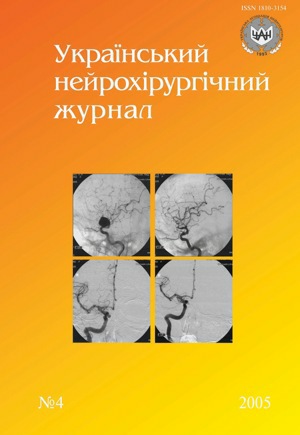The importance of cranium bones fractures proving at expert rating of brain injury severity
DOI:
https://doi.org/10.25305/unj.128599Keywords:
examination severity of traumatic brain injury, evidence-based medicineAbstract
The importance of cranium bones fractures is determined in medicolegal examination (МLE), using the special information system "Expert — CCT", into which database of 27 206 supervision (f.074/o) with cranio-cerebral trauma (CCT) were entered. The CCT treatment outcomes depend on cranium bones fractures, investigated on 2697 case reports (f.033/o). There was a cranium fracture in 1084 (40,2%) cases. The mortality at CCT with the isolated fornix or cranium basis fracture authentically did not differ from number of fatal outcomes at brain bruises in average and heavy degree without cranium fracture. The combination of fornix and cranium basis bones fractures caused to mortality outcomes in most cases and more often, than isolated fractures, that could serve as authentic acknowledgement for MLE of CCT severity with attributes, danger for life. The isolated fornix or cranium basis bones fracture did not influence on a trauma outcome and in studied cases the degree of CCT severity at MLE realization should be estimated on character and severity of traumatic brain substance injuries. These offers should be taken into account, while developing new edition of the Ministry of public health of Ukraine Order on improving MLE of a CCT.
References
Бабанин А.А., Могила В.В., Мороз И.С. Черепно-мозговая травма в судебно-медицинской экспертизе. — Симферополь: Изд. центр КГМУ, 2004. — 109 с.
Верещагин Н.В., Реброва О.Ю. Методы лечения в зеркале доказательной медицины // Лечение нервных болезней. — 2000. — Т.1, №1. — С.33–35.
Лебедев В.В., Крылов В.В. Неотложная нейрохирургия: Руководство для врачей. — М.: Медицина, 2000. — 568 с.
Наказ МОЗ України №6 від 17.01.95 р. “Про розвиток та вдосконалення судово-медичної служби України”. — К., 1995. — 174 с.
Попов В.Л. Черепно-мозговая травма: Судебно-медицинские аспекты. — Л.: Медицина, 1988. — 240 с.
Поліщук М.Є., Верхоглядова Т.П., Лісовий А.С., Шевчук В.А. Клініка та судово-медична експертиза черепно-мозкових ушкоджень. — К.: ТОВ “Тон”, 1996. — 118 с.
Попов В.Л. Черепно-мозговая травма. — Л.: Медицина, 1998. — 239 с.
Семенов А.В., Герасименко А.И., Семисалов С.Я. Судебно-медицинская оценка тяжести повреждений при травматических очаговых подоболочечных кровоизлияниях // Укр. мед. альманах. — 2002. — №6. — С.119–121.
Семисалов С.Я. Информационная система медицинских исследований при острой черепно-мозговой травме // Арх. клин. и эксперим. медицины. — 2000. — Т.9, №2. — С.324–326.
Современные представления о патогенезе черепно-мозговой травмы / И.Г. Васильева, А.Н. Васильев, М.Р. Костюк и др.; Под ред. Е.Г. Педаченко. — К.: ТОВ “Задруга”, 1996. — 282 с.
Черепно-мозговая травма: прогноз течения и исходов / Л.Б. Лихтерман, В.Н. Корниенко, А.А. Потапов и др. — М.: Книга ЛТД, 1993. — 299 с
Шевчук В.А. Судово-медична нейротравматологія. — К.: “МП Леся”, 2003. — 79 с.
Downloads
How to Cite
Issue
Section
License
Copyright (c) 2005 M. I. Shamaev, S. Ya. Semisalov, A. V. Semenov

This work is licensed under a Creative Commons Attribution 4.0 International License.
Ukrainian Neurosurgical Journal abides by the CREATIVE COMMONS copyright rights and permissions for open access journals.
Authors, who are published in this Journal, agree to the following conditions:
1. The authors reserve the right to authorship of the work and pass the first publication right of this work to the Journal under the terms of Creative Commons Attribution License, which allows others to freely distribute the published research with the obligatory reference to the authors of the original work and the first publication of the work in this Journal.
2. The authors have the right to conclude separate supplement agreements that relate to non-exclusive work distribution in the form of which it has been published by the Journal (for example, to upload the work to the online storage of the Journal or publish it as part of a monograph), provided that the reference to the first publication of the work in this Journal is included.









